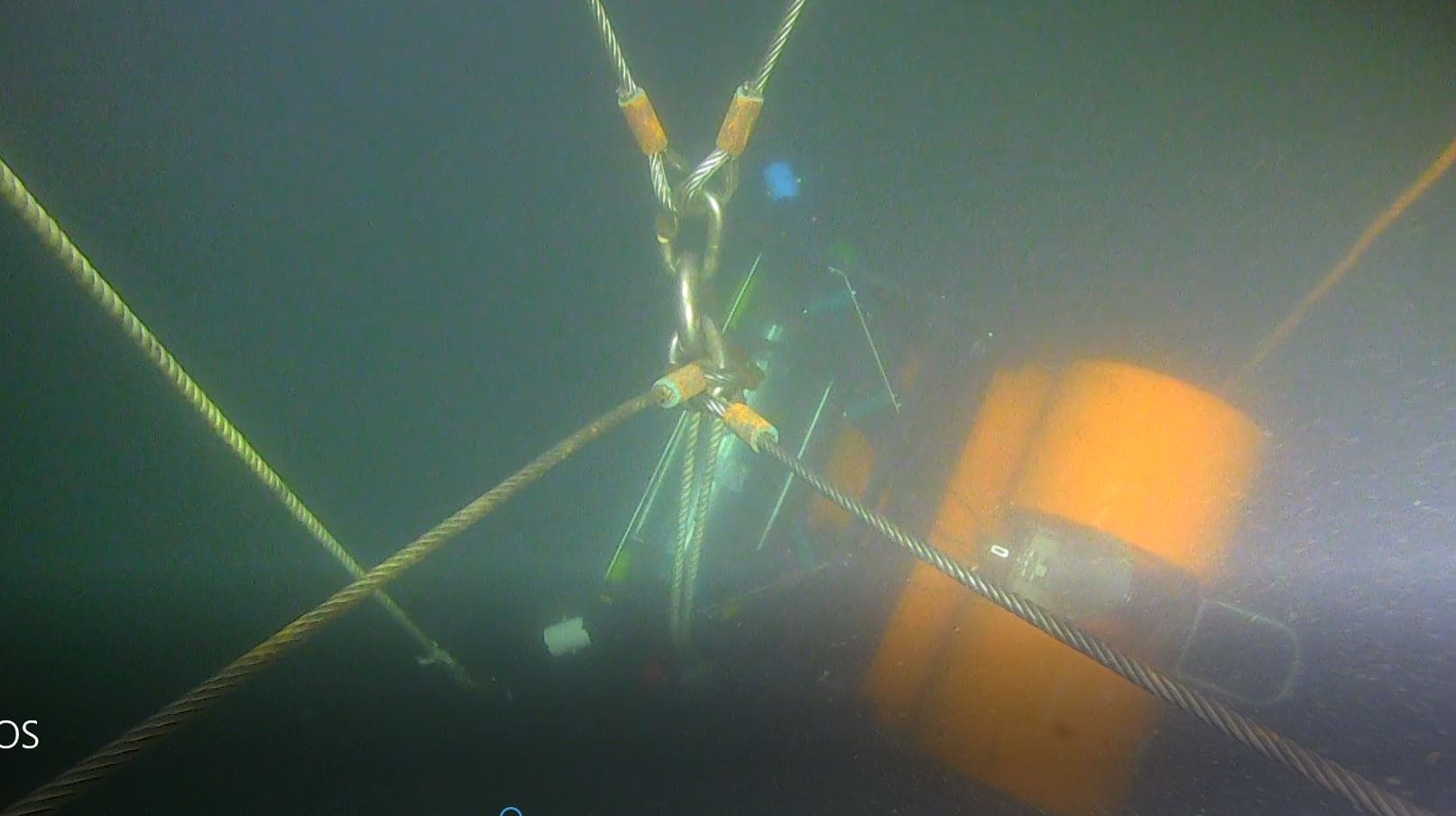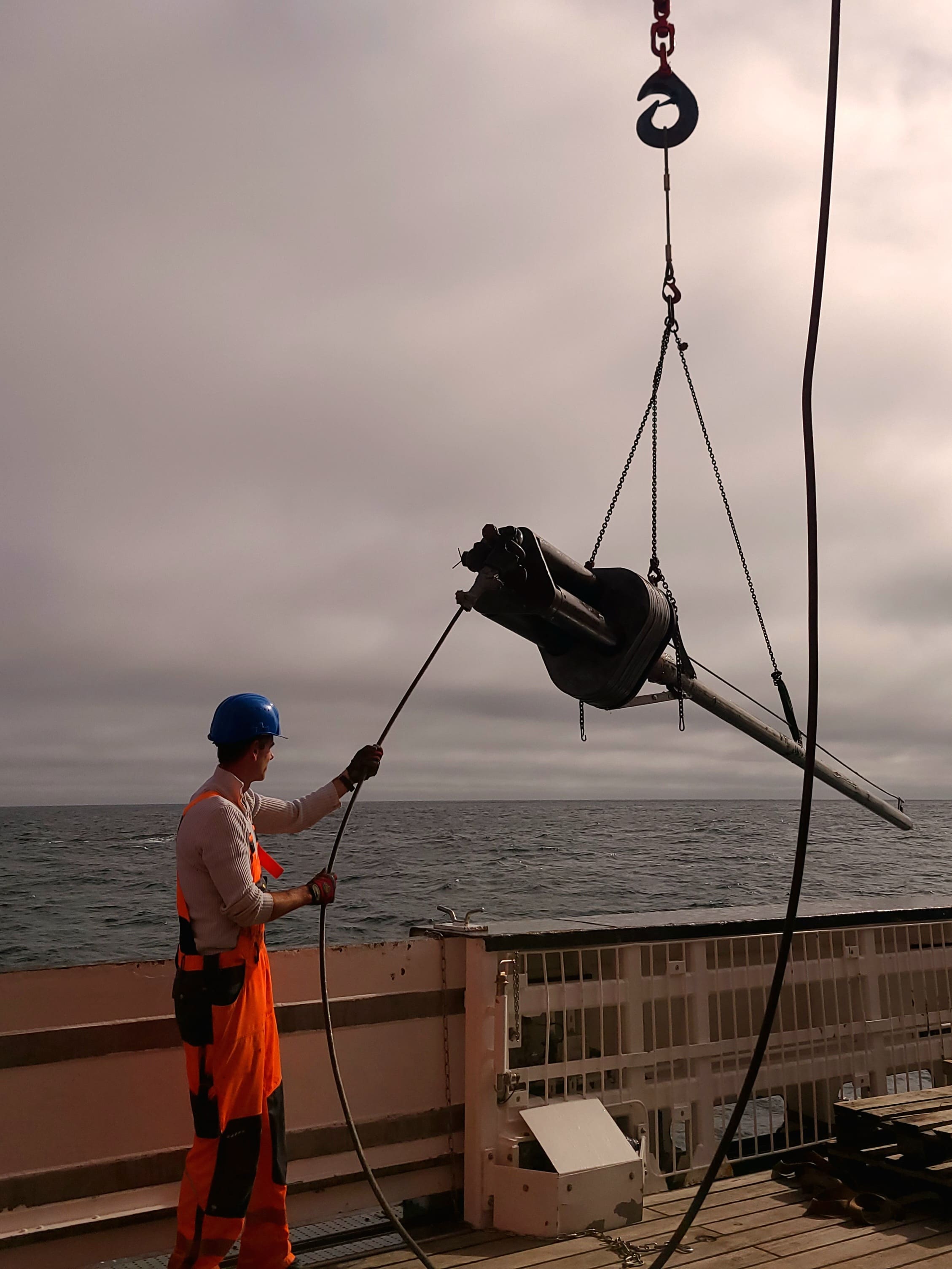———-english version below——–
Auch Wissenschaftler:Innen haben ab und zu Pech und auch in der Forschung läuft trotz aller sorgfältiger Maßnahmen auch mal etwas nicht wie geplant.
In unserem Fall war es das OBMT-13, welches sich trotz mehrmaliger Versuche nicht an die Meeresoberfläche begeben hatte. Das Signal wurde detektiert, allerdings wussten wir die genaue Position nicht bekannt und auch nicht, was die Ursache für die Fehlfunktion war.
Aufgeben? Keine Option für das CLOCKS-Team. Mithilfe von Triangulation wurde bis auf wenige Meter genau, die wahrscheinlichste Position des OBMT bestimmt. Ein Eilantrag an die kanadischen Behörden gestellt, in dem wir darum baten, eine Unterwasserkamera (OFOS) einzusetzen. Nach der Bewilligung begann eine spannende Jagd nach dem verlorenen Schatz, den alle an Bord mit Spannung im Hangar per live-Kamera Übertragung verfolgten. Als nach rund 45 Minuten plötzlich eine orangene Flagge im Bild auftauchte war der Jubel groß. Der Windenführer griff mit einem befestigten Haken einen Arm des OBMT und zog das Gerät nach oben, wo es schließlich geborgen werden konnte.
Was für ein Happy-End! An dieser Stelle möchten wir uns ausdrücklich bei der Crew des FS SONNE bedanken – dank des schnellen und professionellen Einsatzes, konnten wir alle unsere „Schäfchen“ wieder ins Trockene holen.
Who let the seadogs out?
Vor einigen Tagen hatten wir die seltene Gelegenheit, einen Nebelbogen zu beobachten. Dieses Phänomen ist einem Regenbogen sehr ähnlich – er entsteht, wenn die Sonne durch ein Nebelfeld mit besonders feinen Tröpfchen (weniger als 50 µm Durchmesser) gebrochen wird. Seeleute nennen die Nebelbögen mitunter „Sea dogs“.
Can you feel the heat?
Wärmelanze – was klingt wie eine ausgefallene mittelalterliche Waffe, ist ein übliches Gerät in der Untersuchung von thermalen Strukturen im Untergrund. Genau wie das Schwerelot ist es ebenfalls kein seismisches Gerät, sondern misst Parameter, in diesem Fall Wärme, direkt im (oberen) Untergrund. Im Prinzip funktioniert die Wärmelanze wie ein Fieberthermometer.
Während SO294 messen wir mit insgesamt 22 Sonden. Dazu wird ein vorher definiertes Profil punktuell abgemessen, und mehrere Messtationen abgearbeitet. Am Ende bekommt man einen Profilschnitt der Wärmeverteilung in der Oberfläche. Bereits in den obersten Metern des Untergrunds lassen sich nämlich Temperaturveränderungen dort feststellen, wo sich die Erdbebenbruchzone befindet. Die Daten der Wärmelanze fließen also ergänzend in unsere Forschungsergebnisse mit ein.
PART 6 – Against all odds, he made it home
Even scientists have bad luck from time to time, and even in research, despite all the careful measures taken, things sometimes don’t go as planned.
In our case it was the OBMT-13, which did not reach the sea surface despite several attempts. The signal was detected, but we did not know the exact position or what caused the malfunction.
Giving up? Not an option for the CLOCKS team. Using triangulation, the most likely position of the OBMT was determined to within a few meters. An urgent application was made to the Canadian authorities requesting that we deploy an underwater camera (OFOS). After the approval, an exciting hunt for the lost treasure began, which everyone on board followed with excitement in the hangar via live camera transmission. When after about 45 minutes an orange flag suddenly appeared in the picture the cheering was great. The winch operator grabbed an arm of the OBMT with an attached hook and pulled the unit upward, where it could finally be recovered. What a happy ending! We would like to take this opportunity to thank the crew of the FS SONNE – thanks to their quick and professional efforts, we were able to get all our “sheep” back in the dry.
Who let the seadogs out?
A few days ago we had the rare opportunity to observe a nebular arc. This phenomenon is very similar to a rainbow – it occurs when the sun is refracted through a field of fog with particularly fine droplets (less than 50 µm in diameter). Sailors sometimes call the fog arcs “sea dogs”.
Can you feel the heat?
Heat probe – what sounds like a fancy medieval weapon in German (“heat lance”) is a common device in the investigation of thermal structures in the subsurface. Just like the gravity corer, it is also not a seismic device, but measures parameters, in this case heat, directly in the (upper) subsurface. In principle, the heat probe works like a thermometer. During SO294, we measure with a total of 22 sensors. For this purpose, a previously defined profile is measured point by point, and several measuring stations are worked through. At the end we get a profile section of the heat distribution in the surface. Even in the uppermost meters of the subsurface, temperature changes can be detected where the earthquake rupture zone is located. The data from the heat lance ist therefore included in our research results.









